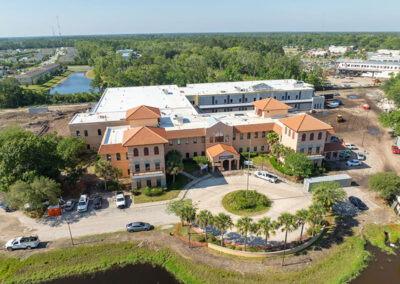Steel Joist Girders
FIRST INTRODUCED IN THE U.S. IN THE LATE 1970’S, STEEL JOIST GIRDERS ARE USED AS PRIMARY FRAMING MEMBERS. THESE OPEN WEB STEEL TRUSSES ARE AN EFFICIENT ALTERNATIVE TO USING WIDE FLANGE BEAMS TO SUPPORT STEEL JOISTS.
Similar to steel joists, the open web truss design of joist girders allows them to support heavy loads with less steel. The design also includes large openings that allow mechanical, electrical, and plumbing infrastructure to easily pass through rather than underneath. The load path through the joists creates concentrated loads that the joist girders must be designed to withstand in order to transfer the building loads back to the columns.
Standard joist girders typically range in depth from 20” to 120” and span from 20’ to 120’. They are most common as parallel chords; however, pitched geometries are available to create a desired roof slope when necessary. Joist girders are primarily manufactured using steel angles to create chord angles, web members, and seats.
The standard connection used for a simple span girder is when the girder rests on top of the column cap plate and the bottom chord angles fit around a stabilizer plate that is attached to the column. The joist girder connection is often designed as a moment connection, which is typically specified by the Structural Engineer of Record. Joist girders are typically braced using knee braces that are designed and located by CSC.
Partner with CSC on your next project
Our relationship with CSC is phenomenal, it's a team, it truly is a team. We're pulling from the same side of the rope.
PROJECT MANAGER
Ira G Steffy & Son








